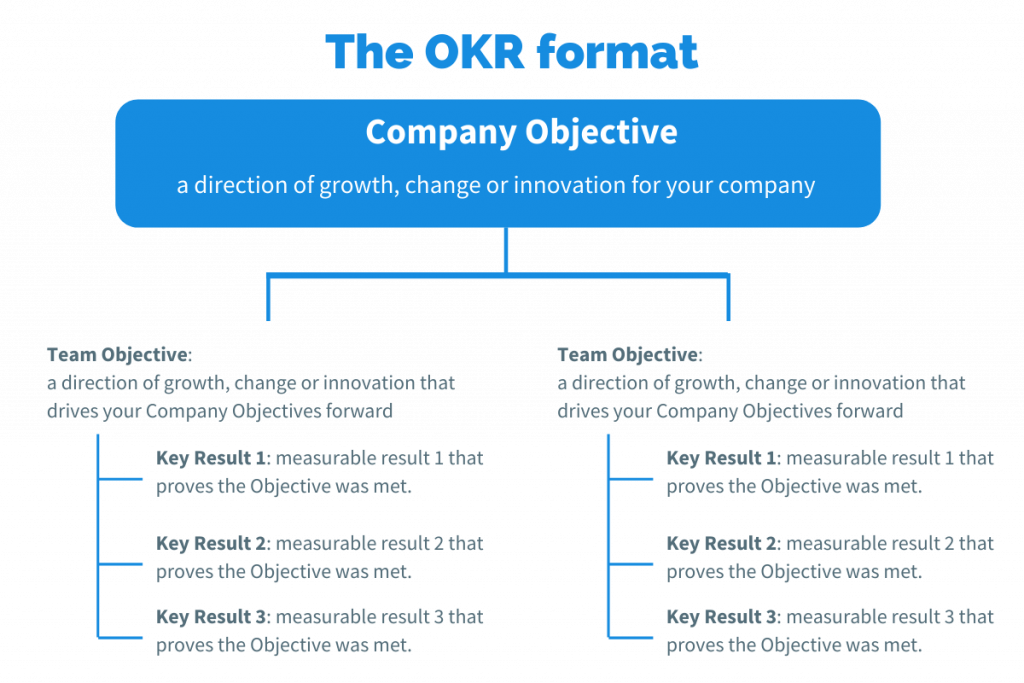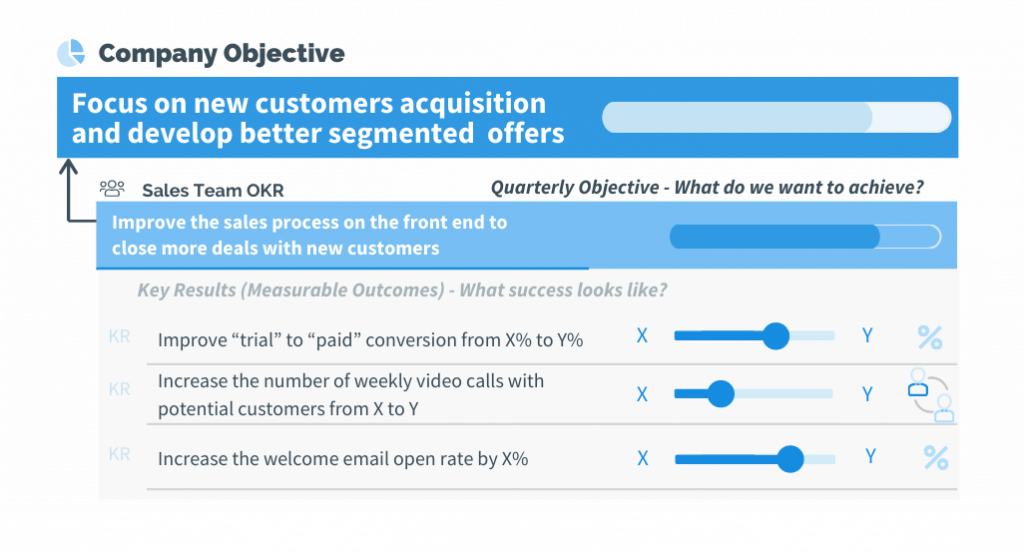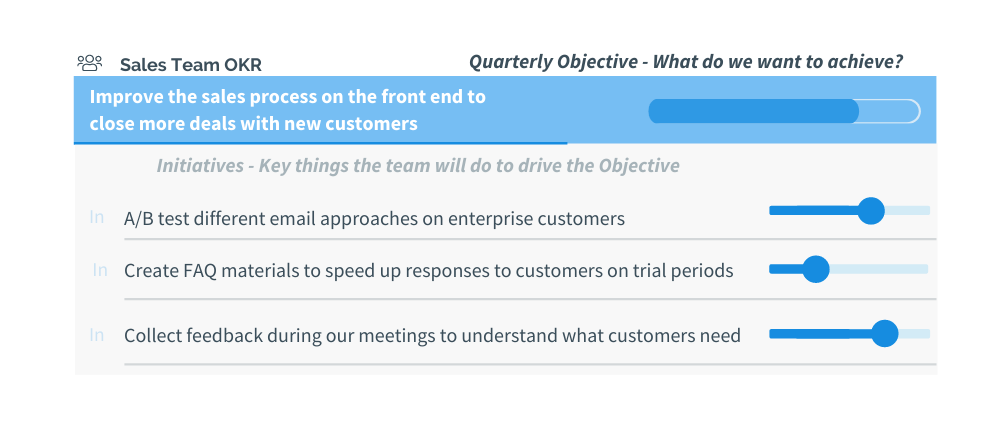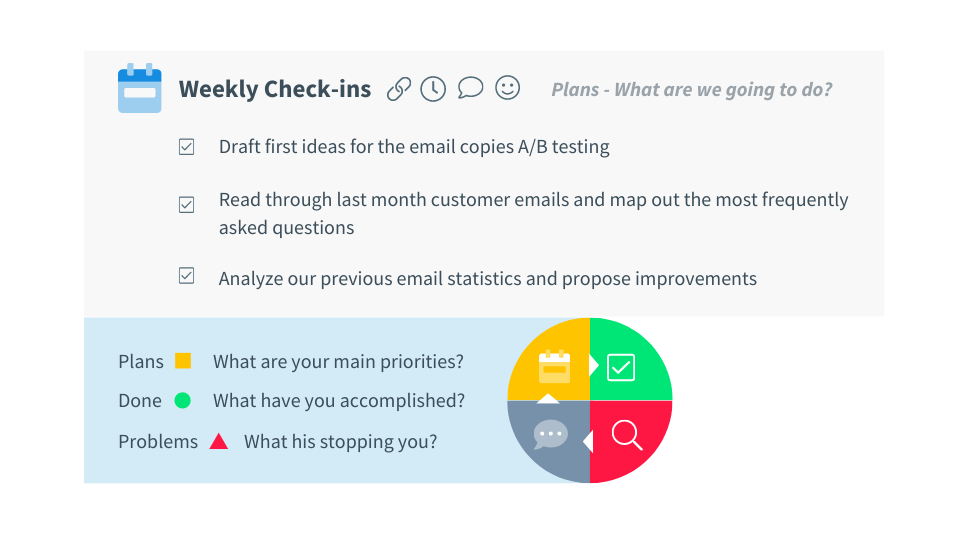OKRs (Objectives and Key Results) are a quarterly goal-setting framework for companies to drive growth, innovation, and improvement. OKRs focus on the most important areas that need improvement and help you deliver valuable measurable outcomes for the business.
OKR levels and cadence
OKRs are a way to lead the organization towards continuous improvements. That means choosing results-oriented and data-driven approach instead of output-focused approach on every level.
There are two main levels for quarterly OKR goal-setting:
- Company-level overarching directional goals (the Company Objectives)
- Team-level operational (actionable) Objectives and their Key Results.
If you follow alignment best practices, the Team level Objectives would become Company level Key Results.

OKRs work best when implemented with a quarterly cadence. It means that new ones should be set at the beginning of each quarter.
Keep in mind that implementing a new approach to goal-setting is a change that commences with management and can then transfer to company culture. Successful OKR rollout starts from the leaders explaining the process thoroughly.
Set qualitative Objectives
Objectives are inspirational goals that give the company and/or the team direction and focus. Objectives are all about improving important focus areas, fixing problems, or driving change. It depends on what the team or a company needs to move forward.

Let’s cross out some bad practices:
❌ Objectives are not projects
❌ Objectives are not your numeric targets
❌ Objectives are not business-as-usual job responsibilities (something you do to keep the lights on)
Teams spend around 20-40% of their time working towards improvement-focused Objectives.
The rest of the time, they still need to work on business-as-usual recurring tasks. Some things just need to be done to keep the company going.
For example, for a Sales team holding sales meetings is a business-as-usual activity. Reducing the sales cycle, on the other hand, is an improvement focus and could be a good Objective for OKRs.
Since Objectives are focused on improving your business, you should only set 1-3 Team Objectives per quarter. If it’s more than that, you would definitely lose focus and not achieve as much as you wanted.
An Objective should say what you are trying to achieve and Key Results would measure if you are succeeding.
Here are some key tips to keep in mind when you are setting Objectives.
Objectives should be inspirational and easy to remember
If most of the people do not know or can’t remember the Objectives the company or team has, it’s also quite hard to make sure that you all are working towards achieving them.
When you are writing an Objective, start with a verb. Do not just write “customer loyalty”. Instead, start with improve, create, increase, maximize, grow, build, leverage, etc.
Frame Objective in the positive language (do more of this rather than reduce something). It’s in our psychology to aspire to growth rather than cutting back on something.
Objectives should be qualitative
This means they should not have something measurable in them. If you put a number into your Objective, people would start listing initiatives as their Key Results. It just guides their thinking in the wrong direction. All the measurements belong to Key Results. You can add numbers if they are not targets but are just there for inspiration, e.g. Become the number 1 SaaS company.
Objectives should be actionable and achievable in a quarter
Sounds easy but it’s actually common to set goals that are too broad and not actionable by the teams independently.
For example, “to reduce churn” is important for sales teams but it is not a good quarterly Objective – it is not specific and not actionable.
First, it’s almost impossible to see a big change like this in just one quarter. It’s too big of an endeavor which means it is not saying anything that would help the team focus.
Second, the churn rate is a consequence of many contributing factors. It’s the question of marketing bringing in enough quality leads, it’s about the product being in demand and keeping customers satisfied and it is also about the current economic situation affecting the business.
The sales team plays its own role in reducing churn and they should set goals that would focus on what the team can actually improve and influence from their side. For example, they could work on improving their long-term relationships with the customers. This is something they can impact, a change they can drive and own.
Objectives should be focused on change and improvement
Objectives focus on problems to solve, areas to improve, or new opportunities to pursue. If an Objective is achieved, it should bring positive business value. E.g. “New marketing plan” is not an Objective because it is not clear why it’s important and what kind of change you want to see.
Why did we need a new plan in the first place and what is it supposed to achieve? Instead, to demonstrate real value, the Objective could be to “Improve our brand awareness”: then more people know about our brand, and it brings value to the business. So do not confuse what you do (Initiatives) with where you want to go (Objective).
💡 Learn more about how to set good Objectives.
Write measurable Key Results
Key Results help us to measure if we are getting closer to achieving the Objective. With Key Results, we define what the success of the Objective looks like. Each Team Objective should have around 2-5 Key Results. The optimal amount is 3.
Key Results need to be measurable, actionable, and timebound. It’s pretty clear in theory but what does it mean in practice? Let’s cover what those words actually mean.
Key Results should be measurable
And they should also be outcome-focused. They are not something you do, Key Results are about the impact and result you want to see after completing a series of projects or tasks.
Confusing Key Results with plans, projects, or deliverables (outputs) is actually one of the main challenges that organizations face, mainly, because there are so many misleading examples on the internet. Delivered output (I did this) is not a measurable outcome (this increased by x%).
Key performance indicators (KPIs) and business targets don’t make good engaging Key Results either. They are just too big to impact within a quarter and they don’t help to focus.
💡 Learn more about KPIs vs OKRs and Outputs vs real Key Results.
Key Results have to be actionable
A common misconception is that “actionable” means that Key Results have to be activities. What actionable actually means is that teams independently should be capable of achieving those Key Results. They should have ideas for initiatives to drive the Key Results forward.
They should not set Key Results which require too much from other teams. And they should not set Key Results which seem impossible to work on at all. Remember, Key Results are actionable but not actions.
Key Results have to be time-bound
Many people think that “time-bound” means setting separate due dates for each Key Result. That’s not the point. Separate projects may have due dates but KRs are set for a quarter.
Key Results are neither milestones nor initiatives, they are the positive change that should come out of executing different milestones, plans, etc. When it comes to a KR, time-bound means that Key Results (and Objectives) are bound to the quarterly cycle and should be achievable by the end of it.
Rules of thumb for writing good KRs
- You need to know exactly where you’re getting the outcome measurement from. How will you know if there was a 15% increase in something if you don’t have data collection in place?
- You should be able to update Key Results every week, or at least every 2 weeks, and definitely at least once per month. Write them in a way that would allow you to track progress regularly, not just at the end of the quarter.
- When drafting Key Results, ask yourself: are we measuring effort or value? (publish 3 blog posts vs get 15% traffic increase to your website; send a survey to 100 people vs receive & analyze 20 survey responses). By writing value-oriented Key Results you will be able to analyze if the tactics you chose delivered desired outcomes, or if you should change the tactics.
- Keep asking Why? So what? and What is considered an improvement? until your Key Results are measuring changes in business, and not just effort or a number of activities completed.
Increase alignment with OKRs
Let’s imagine that Company A has an overarching goal for the quarter to focus on new customers acquisition and develop better-segmented offers. To contribute to this goal, the sales team might set an objective to improve the sales process on the front end to close more deals with new customers.
For this Team Objective: improve the sales process on the front end to close more deals with new customers, the Key Results might be:
- Improve “trial” to “paid” conversion from X% to Y%,
- Increase the number of weekly video calls with potential customers from X to Y,
- Increase the welcome email open rate by X%.

Team Initiatives
Key Results will determine which initiatives the team is going to prioritize and which initiatives to postpone or discard. Initiatives are the key things your team will do to drive the progress on an Objective. Initiatives do not change the progress of an Objective, only Key Results will.
Initiatives for our OKR example might be:
- A/B test different email approaches on enterprise customers
- Create FAQ materials to speed up responses to customers on trial periods
- Collect feedback during our meetings to understand what customers need

Weekly Check-ins
After the teams have set the OKR and agreed on the main initiatives to start with, it’s time for the individuals to start planning their week to work towards achieving the team OKRs. Weekly Check-ins are the most granular and tactical part of OKR execution.
Each week the team members should discuss their OKR and its progress and agree on the next steps to take.
For example, weekly plans to our example could be:
- Draft first ideas for the email copies A/B testing
- Read through last month customer emails and map out the most frequently asked questions
- Analyze our previous email statistics and propose improvements

These plans should be recorded in the Weekly Check-ins section on Weekdone and moved to the Progress category when they are completed.
💻 Learn how to use the Weekly Check-ins feature in Weekdone.
Key Takeaways
- There are two main levels for quarterly OKR goal-setting: Company Objectives and Team OKRs.
- Objective should always include a verb and set a clear direction.
- You should have 1-3 team objectives per quarter to really keep your focus on growth, change and innovation.
- Optimal amount of Key results per objective is 3, but it can vary from 2 to 5.
- Key results should always be measurable, and you should preferably measure value(outcomes) not effort (outputs).
- Initiatives are the key things your team will do to drive the progress on an Objective. Initiatives do not change the progress of an Objective, only Key Results will.
- To be successful, individuals need to set up their weekly plans towards achieving the team OKRs and update the plans regularly.
